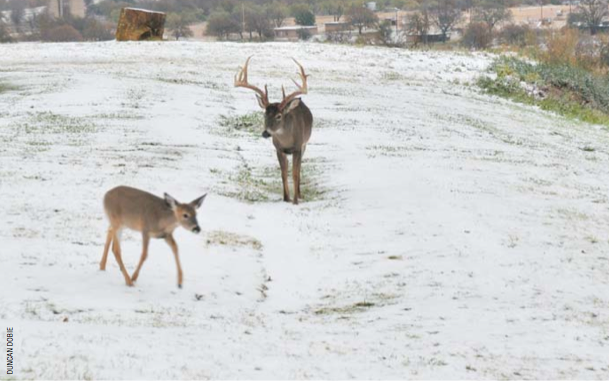
As I picked yet another cactus needle from my knee I smiled thinking about the fond memories of a Texas whitetail hunt in early December 2011.
You always hope every hunt is memorable, and this one certainly had been that. I had hunted on a beautiful ranch with a great outfitter, I had shared camp with some great people and I had taken an outstanding buck. What else could an avid whitetail hunter ask for?
by Duncan Dobie
I had been invited on this hunt by my good friend Joe Coogan, former African professional hunter and host of “Benelli on Assignment” which airs on Outdoor Channel. Coogan had invited me to participate in a trophy whitetail hunt at Greystone Castle, a sprawling 6,000-acre ranch several hours west of Dallas. I would be hunting with a Benneli shotgun. I love hunting with slug guns and that thought was very appealing.
“There’s just one thing,” he said. “Greystone Castle is a high-fence operation. Do you have a problem with that?”

“I don’t have a problem with it but I prefer to hunt low fence, free-ranging deer,” I answered. “I guess it’s just a personal preference that I’ve always had.”
In truth, I prefer to hunt on my own. Over the years, I’ve hunted with only a handful of outfitters. I prefer to set up my own stands and hunt an area the way I want to. That said, back in the ’80s I used to be a deer and elk guide and I have tremendous respect for the important jobs good outfitters and guides do.
“Why don’t you do this,” Coogan suggested. “Why don’t you attend the hunt and afterwards write an objective story about it?”
Geographical Difference
Those who condemn all high-fence hunting might not realize there is a huge difference in hunting a 10,000-acre (or larger) high fence ranch in South Texas versus a 100-acre “deer pen” in Ohio. Most avid hunters would never consider shooting a deer out of such a small enclosure and this is where the concept of “high-fence hunting” gets such a black eye.
Whitetail management was born in Texas and began in earnest after World War II. It got a shot in the arm during the 1960s and ’70s when legendary biologists like Al Brothers and Murphy Ray coined the term “quality deer management” and started managing deer on a scientific basis much like cattle.
Deer were becoming a revenue resource for ranch owners and managing them scientifically for financial gain became a common goal. Ranches were put under high fence purely for the management benefits they helped create. Even in those days, some ranches saw the need to “fence out” certain problems and “fence in” the deer they were trying to manage. Large spreads of 15,000 to 50,000 acres or more were put under high fence at a very high cost to their owners. It was purely an economic and business decision and it had nothing to do trying to make it easier to hunt whitetails.
Dr. Mickey Hellickson of Corpus Christi, Texas, is a respected biologist who for 12 years served as chief biologist for the famed 825,000-acre King Ranch located between Corpus Christi and Brownsville. Today his company, Orion Wildlife Management Services, manages nearly four dozen ranches in south Texas.
“There is a large disconnect with people outside of Texas because they don’t really understand what we do so they tend to condemn the high fence concept and call it unethical,” Hellickson says. “I manage about 45 ranches, and of those, 40 are under high fence. A lot of ‘smaller’ ranches in South Texas ranging from 1,000 to 3,000 acres have been put under high fence in recent years purely because of the management advantages a high fence offers.
RELATED: Intense Whitetail Management Provides Clues to Maximize a Buck’s Potential
“Fences enable a landowner to control deer densities so he can better reach his personal goals,” he said. “Contrary to public opinion, fences certainly don’t make the deer any easier to hunt. The deer are just as wild under a high fence as they are under a low fence. But because of so much bad press, a lot of people would have you believe if a ranch is under high fence you are hunting tame deer. Nothing is further from the truth.”
Hellickson said the vast King Ranch, which historically has always been a low-fence operation with free-ranging deer, proves his point through its stark contrast with high-fence ranches.
“The King Ranch has been lightly hunted for the past 30 to 40 years,” he said. “Because of the exceptionally low hunting pressure, I’ve never seen any operation where the deer are so visible. The flight distance, that is the distance in which you can approach a deer on the ground before they’ll take flight, is about 30 to 40 yards.
“You can actually stalk mature whitetail bucks on the King Ranch and get within bow range because the deer experience such light pressure. As a result, bow hunters take some fine trophies off the King Ranch each year. The deer on the King Ranch are much more visible than they are on many of the high fence operations I manage. They’re still whitetails, and they’re never easy to hunt, but they certainly are easier to see.”
The Castle on the Hill
If you enjoy a beautiful setting, gourmet dining, luxury accommodations and a variety of excellent hunting opportunities ranging from bird and duck hunting to hunting trophy whitetails or a wide choice of exotic species, managed by a friendly and expert staff, you’ll certainly find Greystone Castle to your liking.
December is a busy time at the Castle, and while hunting there in early 2011, I ran into a number of duck hunters having great success with wild ducks. I also ran into several other hunt- ers pursuing Fallow deer. All of these men were ethical hunters and good, hard working people who were fun to be with (not unlike any good hunter you mighty meet in any deer camp across America). Most were repeat customers.
In all honesty, I left Greystone Castle with a better understanding of theimportant role that top quality hunting lodges and high fence operations play in serving the needs of a wide spectrum of hunters.
There are about 12 million deer hunters across America, and every one of us has an opinion about various issues we all face. Some hunters frown on baiting bears. To others it is a tradition. Some hunters frown on hunting over bait for deer, although it is perfectly legal in a number of states.
SEE ALSO: Predator Management is a Hot Issue Due to Fawn Predation
If you’ve ever hunted the brush country of South Texas, you’ll probably agree that the only way to draw deer out of the thick brush is to put corn out on the senderos. Yet some hunters swear that using corn is unethical.
Having grown up in the Deep South, I experienced the thrill of dog hunting in the Low Country of South Carolina and the swamps of south Georgia during my teenage years. Yet some people think hunting with dogs is unethical.
Deer hunters are an opinionated lot. If hunting on a ranch in Texas or anywhere else that is under high fence is not to your liking, don’t do it. It’s really a matter of personal choice. But don’t be so quick to condemn others who do. In fact, if you’ve never hunted whitetails in Texas, I challenge you to make it a destination some day. Texas is a world apart from the rest of the U.S. and it’s an experience you’ll enjoy immensely. You’ll also leave with a different opinion of what real-world whitetail hunting is like in the Lone Star state, whether you hunt under high fence or not.
The Deer Farm Dilemma
As mentioned, one of the big reasons high fence hunting has fallen under such intense scrutiny in recent years is because of the growing number of small deer farms that have sprung up in the last 15 to 20 years in numerous states.
Some of these places are only 50 to 100 acres. For a fee, you can shoot a “trophy” whitetail. Some of these trophy bucks are raised in pens and released shortly before the hunt takes place. Is this fair-chase hunting? Is it ethical? Certainly not by most hunters’ standards. Yet there is a steady demand across the country for this type of operation. As long as there is a demand, it will continue. In any endeavor, you’ll always find certain individuals who try to beat the system, especially where money in involved. It seems like everyone wants to find an easier way to put a trophy whitetail on the wall, and some people are willing to do almost anything to make it happen.
Each of us has our own code of ethics. The key, of course, is to try to live by the standards we set. Our American deer hunting tradition is hundreds of years old. It is rich and honourable. However, there are many different styles of deer hunting. If a guy in Wisconsin wants to do a deer drive, don’t condemn him because you prefer to sit in a tree.
My whitetail hunt at Greystone Castle with Coogin and Steve McKelvain of Benelli was exciting and memorable. I hunted hard for three days on the ground in the rain and mud with my guide, ranch manager John Fredericks, chasing a big 150-class 10-pointer we had spotted. In the end, I shot a beautiful mature 8-pointer that appeared out of nowhere because the 10-pointer gave me the slip.
Duncan Dobie is a whitetail hunting expert, professional outdoor writer from Georgia and the former editor of North American Whitetail.

Get the Best Whitetail Information from DDH TV in This Awesome Compilation …
